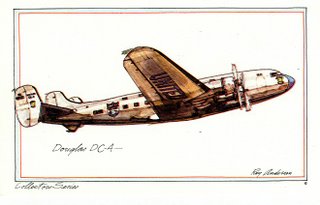
The Douglas DC-4E; While just one was built, it provided a blueprint for later designs
by Peter M. Bowers
This is a classic Of Wings & Things from the 1980s.
Following the commercial success of its twin-engine DC-2 airliner and the then-developing improved version known as the DC-3, the Douglas Aircraft Co. embarked on a really advanced project - the four-engine DC-4. This was later to be designated DC-4E (for experimental) to distinguish it from the considerably different production DC-4 that came out four years later.
Developing so large and advanced a new model was an enormous financial, as well as engineering, undertaking for the time, and was more than Douglas could handle on its own. The project became a cooperative one, first with United Airlines, then American, Eastern, Pan American, and TWA each contributing $100,000 toward the cost and submitting their own technical ideas, service experience, etc.
As originally conceived, the DC-4E was big, with a wing span of 138 feet, was 97 feet long, and ended up with a gross weight of 61,500 pounds. The original passenger load was to have been 42, but this was soon increased to 52, which was still a pretty small payload for so much airplane. Seating was what the airlines now call 2-2, with two rows of seats on each side of a single center aisle. The DC-4E was a dual-purpose plane - a straight day passenger type and a sleeper with 30 to 36 berths. Although the prototype was not pressurized, it was intended that the production version would have this then-innovative feature.
The size of the airplane called for a lot of vertical tail area. Since the maintenance hangars of the day were not very high, the required areas was distributed over three low fins and rudders instead of a single high unit favored today. When later designs had single tails, some existing hangars accommodated them by cutting notches in the structure above the original hangar doors.
Power was supplied by four new-model Pratt and Whitney Twin Hornet engines. The most innovative feature for the time was the use of tricycle landing gear, which had just begun to make a comeback on small aircraft after having been abandoned at the start of World War I. The DC-4E marked its first use on a large modern airplane and its success firmly established the feature for most subsequent airliners (and bombers), starting with the smaller production DC-4, the Lockheed Constellation, and the Consolidated B-24.
As the DC-4E grew more complex and costly in the design and construction stages, the airlines realized that it was not what they really wanted. Although the technology was great, the economics were poor. Pan American and TWA dropped out of the program and bought the slightly smaller Boeing 307, which was basically the four-engine B-17 bomber fitted with a pressurized passenger fuselage. Boeing didn't really capitalize from this switch - requirements during World War II for bombers killed further production of the 307 beyond these two initial orders.
The single DC-4E made it first flight June 7, 1938, and received its Approved Type Certificate in May 1939. Although Douglas was in the hole more than $1.3 million on the project, it was not all loss. The experience gained in systems, structures, and aerodynamic development was of great value to later designs. The Twin Hornet engine was likewise a one-shot and was not used in a production airplane.
Late in 1939 the DC-4E was sold to Japan. This was ostensibly for use by a Japanese airline, but the buyer turned out to be a front organization for the Japanese Navy. The quick disappearance of the airplane was attributed to a training crash in Tokyo Bay when actually it was disassembled in an aircraft factory and used as the model for a very similar four-engine bomber that likewise never got beyond the prototype stage.
________________________________________________________________________________________________________

0 Comments:
Post a Comment
<< Home